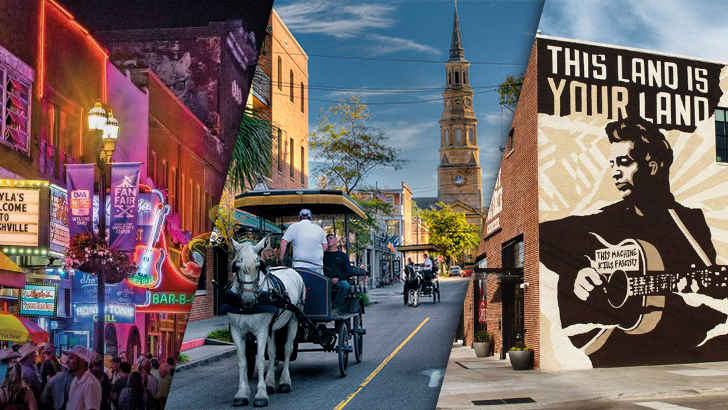TRENDING
The Fastest Growing Cities In The U.S.
Published
3 years agoon
Just about everybody dreams of finding the perfect place to live – a city or town that offers everything you find ideal in life from budget to lifestyle. There’s been quite a bit of shuffling lately when it comes to real estate, with so many people and families relocating to cities and regions that feel just a little more like home.

Currently, however, there are several seemingly-perfect cities that people are actively seeking in droves. Looking to relocate and want to find your ideal haven? Or maybe you just want to see if you already live in one of these desirable cities. In any case, read on.
San Antonio, Texas

The San Antonio metropolitan area saw staggering growth between 2010 and 2019, as evidenced by a 19% population increase. Not only does it offer affordable living with goods and services costing around 6% less than the national average, but it also offers a nice balance of big city living and European leisure.
Raleigh/Durham, North Carolina

The Carolinas are already considered by many to be a gorgeous region to live in, but the Raleigh/Durham area in particular has exploded in growth thanks to affordable housing and 3.4% lower cost of living. In fact, it’s been named as one of the best places to live in America due to its exceptionally family-friendly environment.
Fayetteville, Arkansas

There’s plenty of rustic, traditional charm for everyone in Fayetteville, even for the thousands of families relocating there. As such, this city is among the most fast growing communities in the south-east region. Whether it’s peace and quiet or the quaint small-town feel that still offers many major amenities, it’s little wonder that it’s experienced such growth over the years.
Spartanburg, South Carolina

In just the span of a decade, the Spartanburg area surged in population by a surprising 6% per year. It’s the second-fastest growing area in South Carolina, mainly because of its commitment to preserving a simpler, calmer way of life while still offering extensive opportunities for the arts. In fact, it’s estimated that by 2025 the area will be home to around 356,350 residents.
Melbourne, Florida

Florida is already a hugely desirable place to plant your flag, but Melbourne in particular has been growing steadily over the past decade. It may not have Disney World, but Melbourne more than makes up for it in gorgeous beaches and peaceful living. As of 2021, it peaked in population at over 84,000, and that number just keeps growing.
Eugene, Oregon

Those who love the Pacific Northwest aesthetic have found Eugene to be that perfect blending of natural beauty and urban structure. As such, the town is currently growing at a rate of 1.10% annually and see no signs of slowing down in the near future.
Salisbury, Maryland

Around 70% of Salisbury home buyers are from the D.C. area, with many of these relocators mainly looking for a reprieve from D.C.’s high cost of living. Salisbury’s cost of living is over 11% beneath the national average, so you can imagine how much of a reprieve it must be! But everyone who moves to Salisbury agrees that affordable housing is just one of the many perks of a city that has space to breathe but also has many adult and family-friendly options.
Orlando, Florida

Just in the past year alone, Orlando has experienced some of the most exponential growth. Even before this past year, the city still experienced incredible growth by well over 17% from 2010 to 2019. Even if Universal Studios or Disney World isn’t your thing, Orlando still has a massive amount of entertainment and venues between the city and outlying areas.
Boise, Idaho

According to Forbes, Boise is currently #15 on the fast growing U.S. cities list. In fact, Boise remains one of the most desirable locations for Californians. Its strong industrial infrastructure and healthy economy offers plenty of incentives for business, while also providing the quaint, suburban feel that many desire.
Fort Collins, Colorado

For people who loved the crisp Colorado weather but didn’t exactly want Denver’s larger population, Fort Collins offered the perfect alternative. As such, the city grew by over 20% from 2010 to 2019 and flourished under the growth. Now it’s become an epicenter of social rapport with families in mind.
Port St. Lucie, Florida

For those who value Florida’s renowned coastal climate as well as small town living, Port St. Lucie is the ideal place to call home. Just watch out for the golf carts! Many have found this city’s charm to be irresistible, as it’s currently growing at an annual rate of 3.37%, placing it at #7 on Florida’s largest cities list.
Grand Rapids, Michigan

Grand Rapids has exploded in population during this past decade, thanks in large part to some of the cheapest cost of living rates in the country. In the wake of Detroit’s gradual decline, Grand Rapids has quickly become one of the top alternatives for those who appreciate the town’s urban atmosphere but with suburban prices.
Virginia Beach, Virginia

Somewhat surprisingly, nearly half of Virginia Beach’s recent residents have come from the Washington, D.C. area. Unsurprisingly, the vast majority of them have stuck around, and it’s not difficult to see why. Virginia Beach offers all the main conveniences of a major city, but with miles of golden sandy beaches literally within sight. Add on top of that the fact that the median household income is over $3,000 higher than the national average median, and you have yourself one stupendously-desirable place to call home.
New Orleans, Louisiana

Proof that soulful jazz and zesty backwater cooking can make any city bounce back from anything. In the most recent decade, the iconic American city has seen people relocating from all over the country, although an estimated 9% have moved there from Los Angeles. Regardless of where they come from, the majority of new residents agree that New Orleans’ sense of frivolity and ease is exactly the right fit for them.
Tucson, Arizona

Sometimes you just can’t beat lower than average cost of living, and Tucson excels at it. Cost of living is over 6% lower than average, which means that people living on incomes of $55,000 to $60,000 can more than live comfortably. But this city also offers extensive cultural amenities, as well as that classic Hispanic-southern motif.
Daytona Beach, Florida

If living the low-key Florida life but in an Atlantic City-esque setting is your thing, then Daytona Beach should be your new home. Thanks to extensive tourism, the city has flourished under the economic boost, not to mention the added population. In 2021, Daytona Beach topped its population numbers with 70,140.
Atlanta, Georgia

While Atlanta saw steady growth before the pandemic, it was during this past year especially that the city saw such exponential growth – particularly from people leaving New York. This has made Atlanta one of the largest metro cities in the country. However, despite being a major city, it doesn’t have the major city prices. On average, the cost of living is 2.7% lower than the U.S. average.
Phoenix, Arizona

Another city that gained a massive influx of new residents during the pandemic, Phoenix has boomed during this past year. Not only do people enjoy the sunny (if perhaps sometimes too sunny) climate, but they also vastly appreciate the lower cost of living. And that’s in addition to having a higher average median household income by around $2,000. With impressive numbers like that, it’s little wonder that Phoenix is growing so rapidly.
Sarasota, Florida

Even through recessions and pandemics, this small town has continued to grow in incredible leaps and bounds. The 2019 census showed that just under 57,000 people called Sarasota home, and the growth has shown no signs of slowing. Whether it’s the cultural arts or the relaxed feel, Sarasota offers something for just about everyone.
Louisville, Kentucky

While Kentucky isn’t the first state that comes to mind when thinking about urban growth, Louisville has proven how well they can handle exponential expansion and the infrastructure changes needed to support it. Thanks to a reasonable sales tax of 6% and a projected future job growth of over 38%, this Kentucky city has quickly become a viable option for families and businesses alike.
Santa Barbara, California

As once-staple California cities like L.A. are being emptied, cities like Santa Barabara are absorbing much of that exodus traffic… and it’s fairly easy to see why. Between European-style shopping and dining venues and absolutely gorgeous scenery, Santa Barbara’s large appeal has a wide reach.
Buffalo, New York

Though Buffalo’s census once steadily declined over the decades, the city is starting to turn that around by attracting larger amounts of millennials. This has largely been due to an increased focus on driving more tech-based businesses to the area. And there’s no inclination of things slowing down anytime soon.
Ocala, Florida

Widely considered to be Florida’s hidden gem, Ocala has proven a true oasis for people seeking the easy life. Thanks in large part to its idyllic crystal-clear Silver Springs park, tourism increased over the years and led this once-tiny community to increase its industrial infrastructure, and all while simultaneously retaining it’s charming small town vibe.
Burlington, Vermont

Burlington is currently Virginia’s fastest growing city, primarily attracting people on the more ultra-liberal and free-thinking side who value its rich urban density. Cost of living is far higher than the national average, but its intimate atmosphere and rich autumn colors make it far worthwhile for those who call it home.
El Paso, Texas

Though it hasn’t grown quite as quickly as other Texas cities during the last decade, El Paso has still grown by a considerable 5%. For many residents, the “Sun City’s” uniqueness lies in its pure Tex-Mex cuisine and its close proximity to Juarez, Mexico.
Little Rock, Arkansas

Through economic uncertainty, Little Rock has grown slowly and steadily the entire way. Thanks to its higher than average homeownership rates, families especially have been more than happy to call Little Rock home. And in return, the city has cultivated many family-friendly venues to accommodate this growing and expanding influx.
Tulsa, Oklahoma

It’s clear to see how Tulsa’s focus on growing its industry has benefited them. Some of the nation’s largest companies have set up shop in Tulsa, with some key sectors being energy, health care, technology, transportation, and manufacturing.With so much business booming, Tulsa has grown at a small but steady rate.
Greenville, South Carolina

While many cities dwindled in population in the midst of the pandemic, Greenville continued to thrive just as it had before. Its urban atmosphere and intimate social infrastructure is just the right sweet spot to attract what is now 68,000-some residents. This is a city that’s poised to become an economic leader in the 21st century.
Lakeland, Florida

Nestled just adjacent to Sarasota is Lakeland, a cozy little community that has experienced just as much rapid growth. Between 2010 and 2019, the town’s size grew by over 20% percent, and that number just keeps growing. People who love Florida’s weather and sense of leisure are quickly realizing that Lakeland is the place for them.
Knoxville, Tennessee

It may only be the state’s third-largest city, but Knoxville is still experiencing exponential growth. As of 2021, the city has reached a record population of 188,085, and there’s no indication that it’ll stop there. If southern comfort in an urban setting is your way of life, then look no further than Knoxville.
Miami, Florida

You could definitely say business is booming for Florida’s most diverse and unique city. Nearly half a million people have fallen in love with the city’s vibrant Latin-American influence and picturesque beaches. And if that doesn’t do it for you, there’s always the world-class nightlife and authentic Cuban cigars.
Austin, Texas

Austin is quickly proving why you never mess with Texas. Even Miami can’t keep up with Austin’s unprecedented growth, especially in the wake of the real estate upheaval during the pandemic. It’s quickly become a magnet for Silicon Valley-type business ventures, especially in the tech sector, as well as artists and musicians.
Henderson, Nevada

Second only to the great Las Vegas, Henderson’s lakefront views (a rarity in such a dry state) have turned the leisurely city into one of Nevada’s premier places to live. In just 20 years, the population went from a respectable 175,000 residents to currently 340,000! Henderson’s affordable cost of living and high-end amenities have been a boon for so many fed-up people moving away from nearby California.
Tampa, Florida

For those who don’t want Miami’s bustling feel or Lakeland’s lazy aura, Tampa has proven to be a perfect alternative. It offers a large city feel without feeling so cramped, and it has many outdoor and indoor recreational options for those who still seek the benefits of living in Florida. During the past decade, Tampa has especially accumulated a larger than average younger population.
Nashville, Tennessee

If you enjoy a myriad of nightlife options and a large city vibe but with a rustic twist, then you’re just like thousands of others who are finding themselves making the Music City their permanent home. Nashville’s population grew by 17.5% from 2010 to 2019, which is more than double the average metro area growth rate. Nashville has especially seen wide popularity among those moving out of New York City, Chicago, San Francisco, and Los Angeles.
Charlotte, North Carolina

Not only does the Charlotte area boast some beautiful fall-time natural aesthetics, but the city also has a slightly higher than average household income. On top of that, Charlotte’s cost of goods and services is around 5.8% less expensive than the national average, so it’s not very difficult to see why people are choosing this area to relocate.
Dallas, Texas

While Chicago currently holds the #3 spot on the largest U.S. metro cities, Dallas isn’t far behind and is projected to overtake that #3 spot by 2030. The Dallas area added the most new residents of any other metro area in the nation – around 400 residents every day, or over 146,000 over the course of a year. Just more proof that everything’s bigger in Texas.
Denver, Colorado

Whether it’s the world-class cultural attractions, the renowned breweries, or simply the close proximity to the Rockies, Denver is a thriving city that seems to have something to offer for everyone. As such, Denver has experienced consistent annual growth of around 1.48%, and it doesn’t seem like there’s going to be any kind of slow down anytime soon.
Fort Myers, Florida

Like most other Florida cities on this list, Fort Myers has that classic Florida vibe while still offering plenty of opportunities to engage in some high-end nightlife or some lazy beach life. Cost of living is around 2.2% lower, which has been a huge draw for people (especially during the pandemic) and is a large reason why the city has expanded by a whopping 25% in the past decade.
Las Vegas, Nevada

The appeal of Sin City will never die, it seems. As other major cities around the country have seen huge dips in population, Vegas has consistently grown by a rate of 1.23% annually. It also saw a 14.35% increase in population between the 2010 and 2019 census years. And as the city is nearing full opening after the pandemic, that number should continue to climb.
Charleston, South Carolina

As New Yorkers left in droves in 2020, Charleston quickly became a popular destination for those who were tired of paying New York’s premium housing prices – and many haven’t regretted it since. After all, Charleston’s cost of living is already over 3% lower than the national average, so for New Yorkers that difference was even more significant.
Jacksonville, Florida

As people have poured into the state of Florida, Jacksonville has quickly proven itself as one of the more sought-after cities for families and businesses alike. Whether it’s the natural beauty or the renowned Florida beaches, people have had little problem with calling Jacksonville their new home.
Naples, Florida

It may not be the Naples in Italy, but the Florida version still has its fair share of charm – not to mention plenty of sunshine! This cozy city offers high-end dining and shopping options, not to mention a fine cultural sense, all while still offering affordable living options for families and retirees alike.
More Movies + TV Shows
-


Man Proposes in McDonald’s in Sandton, Johannesburg and is Denied…
-


Famous 70’s Actresses Then And Now
-


Archive 81 Review
-


Vintage Ads From The Past You Won’t Believe
-


Dog Review
-


Travel Hacks To Ensure A Carefree Vacation
-


Black Bear Pays a Visit to Cabin in Pennsylvania
-


Celebrity Weight Loss Transformations
-


These Beloved Movies Were Originally Massive Flops
-


Woody Harrelson Hits Cannes to Unveil His New Black Comedy…
-


Photographer Travels The World To Document Female Beauty
-


25 Prospect Cities For The NFL

